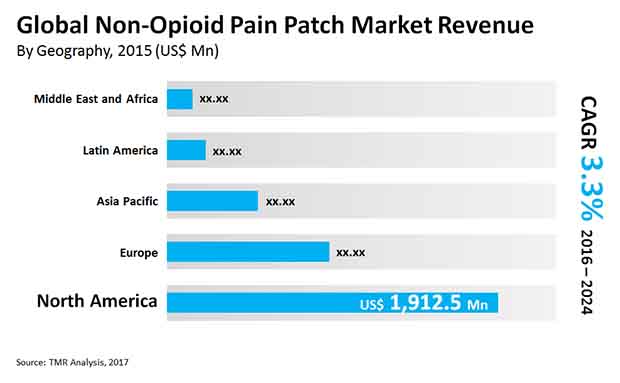Non-opioid Pain Patch Market by Patch Type, End Users & Forecast – 2024 | Transparency Market Research
Global Non-opioid Pain Patch Market: Need for Non-addictive Chronic Pain Treatment to Foster Growth
Researchers have prioritized the search for non-opioid drugs with escalating rates of opioid addiction. For years, physicians had been providing an aggressive treatment for chronic treatment resulting in narcotic-addiction among patients. However, the healthcare industry is no longer marrying the concept of pain relief with narcotic analgesics. Medical pain-management as a whole is drifting away from addictive procedures or treatments towards evidence-based treatments using non-opioid analgesics.
Request Sample Of Report – https://www.transparencymarketresearch.com/sample/sample.php?flag=S&rep_id=26168
The sharp rise in the number of overdose deaths only echoes the magnitude of the crisis caused by the opioid epidemic. According to the World Health Organization, 27 Mn people suffered from opioid disorders in 2016. Overdose deaths accounted for around a third and a half of all the drug-related deaths.
The rising popularity of non-opioids as the “analgesics of the future” and efforts focused on tackling the crisis of “opioid epidemic” calls for a need to conduct an in-depth analysis of the non-opioid pain patch market. In its latest offering, Transparency Market Research talks about how the changes in healthcare trends and consumer demographics have impacted the market’s evolution.
Request the Coronavirus Impact Analysis on this Market – https://www.transparencymarketresearch.com/sample/sample.php?flag=covid19&rep_id=26168

A Walk through the Evolutionary Timeline
As the consumers realized the ill-effects of opioid treatment, companies manufacturing and marketing these drugs faced public backlash. This acted as a stepping stone for the development of new non-opioid treatments which have redefined the non-opioid treatment market’s growth. In a bid to promote the use of non-opioid analgesics, the U.S. Food and Drug Administration (FDA) launched a campaign called the “innovation challenge”. It was aimed at the development of medical devices that could combat opioid use disorder.
The non-opioid pain match treatment market has come a long way from the development of the first patch product for PHN treatment in 2013 to the launch of OTC water-free lidocaine patch in March 2016. Furthermore, in February 2018, Tremeau Pharmaceuticals, Inc., closed the equity raise of $5.2 Mn to fund non-opioid treatments for rare diseases.
With the escalating new developments, the global non-opioid pain patch market is poised to rise from its initial valuation of US$ 3,750 Mn in 2015 to reach US$ 4,983.3 Mn in 2024. However, the high popularity of oral pain relief drugs due to their ability to mitigate pain in a short duration may act a stumbling block in the non-opioid pain patch market.
Buy this Research Report Now – https://www.transparencymarketresearch.com/checkout.php?rep_id=26168<ype=S
Trends Causing a Stir in the Non-opioid Pain Patch Market
Rising Popularity of Transdermal Drug Delivery
Transdermal delivery despite being an unexplored aspect of drug delivery is gradually entering the league of blockbuster drugs. Capitalizing on this riveting trend, non-opioid drug manufacturers are developing transdermal non-opioid painkiller patches. Moreover, the Food and Drug Administration is keen on approving transdermal drugs because of their efficacy in reducing postoperative pain. For instance, in March 2018, the FDA approved the non-opioid painkiller patch developed by Sorrento. Market players are not only launching new non-opioids but relaunching high-selling NSAIDs as into transdermal drug delivery systems.
Replacement of Existing Pain Patches with Next Gen Patches
In a bid to enhance the efficiency of the pain patch treatment, leading players are concentrating their efforts on upgrading the existing pain patches or replacing them with next-generation pain patches. This trend of introducing the existing drug with a better design has helped manufacturers garner considerable attention from the physicians and the patients. One such example of upgradation of pain patches is the study conducted by SCILEX Pharmaceuticals Inc., for the development of ZTlido, an anhydrous patch created using the patented technology. The development of such trailblazing products has amplified the adoption of non-opioid pain patches for the treatment of chronic pain.
More Trending Reports by Transparency Market Research – https://www.biospace.com/article/bioengineered-protein-drugs-market-advancement-in-the-biopharmaceutical-field-to-stoke-demand-in-the-market/

